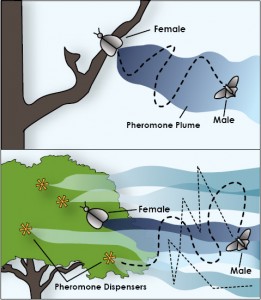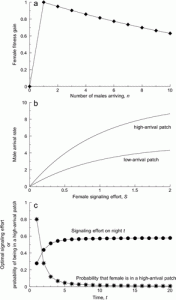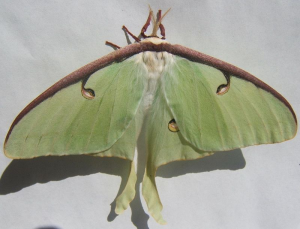Have you ever wondered what the best way is to get the attention of someone you fancy? Being too subtle could result in that person not noticing you, but being too overt could lead to unwanted attention from other suitors and other unsavory individuals. What’s more, you also have to worry about your biological clock ticking away! This is the same predicament in which female moths and butterflies tends to find herself. Researchers in Australia investigated mathematically the optimal strategies used by female members of the order Lepidoptera to attract potential mates before it’s too late.
In most sexual species, courting can be considered one of the most important processes for survival. However, the specific courting rituals vary widely across different animal species. For many moths and butterflies, males do most of the grunt work. In fact, male moths have developed such finely-tuned antennae that they can detect the pheromone plumes of a female from over 10 km away, or a little over 6 miles! Pheromone plumes are species-specific chemical signals produced by female moths to garner the attention of any potential mates in the area. The problem for these aging virgins is knowing how “loud” to make that signal. If she calls too quietly, then she might die before a male can find her. But if she calls too loudly, she might garner the attention of too many males, or even any eavesdropping predators.

Females produce a pheromone plume which males can follow to find their mate. Sometimes, environmental factors can create a chemical disruption, making the female’s trail hard to follow. What results is the delay of prevention of mating. Source: Murray & Alston, 2010
Arguably the greatest threat to female fitness is the delay or prevention of finding a mate. But another consideration that aging virgins have to make is the cost of that signal. Direct costs involved with mate selection include the minimal energy required to produce and emit a pheromone plume as well as the risk of attracting unwanted guests, such as parasites and predators. Even attracting too many males is suboptimal for females, as it could reduce their reproductive success. Umbers et al. (2015) hypothesized that even for a small cost of production, female virgins will start out signaling less intensely, and increase signaling effort as they get older and gather evidence on whether mate availability (sperm limitation) threatens reproductive success.
Using statistical models based on empirical data available on Lepidoptera, Umber et al. (2015) supported their prediction; they found that the time females spent calling was the more critical to successful mate attraction rather than the intensity of the signal itself. This theory can be explained since signaling earlier than other females of your species each night is a more reliable and cost-effective strategy to attract a suitable mate than simply producing a more concentrated pheromone plume. This data coupled with another mathematical model describing the precision with which a pheromone plume travels in any given environment contributes to the validity of their results.

a) Female reproductive fitness depends on the number of males she attracts each night. One male is the optimal result, and there is a slow decline with the number of excess male suitors.
b) Depending on the environment in which the female finds herself, signaling effort may increase the rate of male attraction more or less steeply.
c) The optimal signaling strategy for female virgins over time.
Source: (Umbers et al., 2015)
So the big question now is, so what? Why do these results matter in the greater scope of scientific exploration? Moths show great potential as a model organism for understanding the female side of mate acquisition. Furthermore, studying this process can help scientists understand how reproductive strategies affect the life history of females. Furthermore, this study is the first to examine the relationship between time and intensity in the scope of energetic cost. Overall, this paper provides the groundwork to improve our understanding of reproductive fitness.
References:
Murray, M. & Alston, D. (2010). Codling Moth Mating Disruption. Utah State University Extension. Retrieved from http://utahpests.usu.edu/ipm/htm/fruits/fruit-insect-disease/codling-moth-md10
Umbers, K. D. L., Symonds, M. R. E., Kokko, H. (2015). The Mothematics of Female Pheromone Signaling: Strategies for Aging Virgins. The American Naturalist 185(3): 417-432.
Wiki Commons (http://commons.wikimedia.org/wiki/Category:Images)

